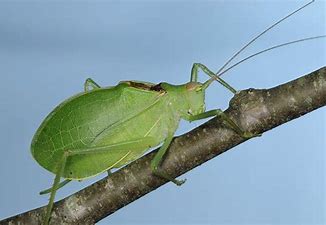By Saundra McBrearty, Outreach and Volunteer Specialist
The serenading songs of insects fill the landscape through the dog days of summer. And it is fun to tease out the various sounds and singers we hear. In the daytime we hear the buzz of cicadas. At night we hear the Ch-ch-ch of katydids and high tone ringing of crickets.
Did you know that people who study cicadas, katydids, and crickets are called grigologists? You do not have to be a scientist to enjoy these late summer sounds. To hear them, however, go outside and visit a park now because after the first hard frost the insect songs will be silent until next year.
Cicadas
 Two common types of cicadas live in Ohio. The annual cicadas (Tibicen chloromera), also known as the dog day cicadas, come out and sing every year. The dog days cicada name is a nod to the constellation Canis Major which rises in the night sky. The other type of cicada is the periodical cicada (Magiciacada spp) which emerges in abundance every 17 years. We heard periodical cicadas in our region last summer. Only the male cicadas make the call and do this by vibrating internal structures within their drum-like abdomen in hopes of attracting a mate. Here is what a cicada looks and sounds like:
Two common types of cicadas live in Ohio. The annual cicadas (Tibicen chloromera), also known as the dog day cicadas, come out and sing every year. The dog days cicada name is a nod to the constellation Canis Major which rises in the night sky. The other type of cicada is the periodical cicada (Magiciacada spp) which emerges in abundance every 17 years. We heard periodical cicadas in our region last summer. Only the male cicadas make the call and do this by vibrating internal structures within their drum-like abdomen in hopes of attracting a mate. Here is what a cicada looks and sounds like:
Dog-day cicada – Tibicen canicularis
Dog-day Cicada | Songs of Insects
Katydids
 The common true katydid (Pterophylla camellifolia) gets its name from their sound, produced by rubbing their ridged wings together. Both genders sing at night and the song sounds something like “katy-did, katy-didn’t.” The common true katydid is a great sound to begin identifying in the night.
The common true katydid (Pterophylla camellifolia) gets its name from their sound, produced by rubbing their ridged wings together. Both genders sing at night and the song sounds something like “katy-did, katy-didn’t.” The common true katydid is a great sound to begin identifying in the night.
Learning the various calls of katydids is a grigologist’s adventure. There are 255 species of katydids found in North America and twenty species found here in the Midwest. Katydid songs are species-specific and distinct species are able to hear one another’s calls. Songs differ as to their purpose, being either reproductive, territorial, aggressive, or defensive in nature.
Here is what common true katydids look and sounds like:
Common True Katydid | Songs of Insects
Crickets
 The Carolina ground cricket is common across Ohio and the United States. Their persistent high pitch call rings in the night like constant background noise. Carolina ground crickets are surprisingly cold tolerant and will be the last of the crickets singing as winter fills the land. Listen here to their call.
The Carolina ground cricket is common across Ohio and the United States. Their persistent high pitch call rings in the night like constant background noise. Carolina ground crickets are surprisingly cold tolerant and will be the last of the crickets singing as winter fills the land. Listen here to their call.






